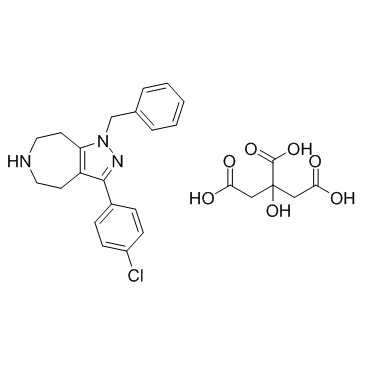| Description: |
JNJ-18038683 is a potent, selective 5-HT7 receptor antagonist with pKi of 8.19 and 8.20 for rat and human 5-HT7 in cell-based assays; decreases 5-HT (100 nM)-stimulated adenylyl cyclase in rat and human 5-HT7/HEK293 cells with pKb of 8.01 and 7.99, respectively; shows 10-fold selectivity over h5-HT6 receptor, 15-fold selectivity over rat adrenergic α1 receptor, 14- to 25-fold selectivity over the h5-HT2 receptor subtypes, and 20-fold selectivity over h5-HT1B receptor; prolongs rapid eye movement (REM) sleep and decreases REM duration induced by citalopram in vivo.DepressionPhase 2 Clinical |
| Target: |
Rat 5-HT7 Receptor:8.19 (pKi, in HEK293 cells )
Human 5-HT7 Receptor:8.20 (pKi, in HEK293 cells ) |
| In Vivo: |
JNJ-18038683 dose-dependently suppresses REM sleep mainly during the first 4 h after the treatment. The duration of REM sleep is significantly decreased from the dose of 1 mg/kg onward (P<0.05) during the first 4 h after oral administration. Concomitantly, the REM sleep latency tends to be prolonged in a dose-related manner with a significant increase in REM latency occurring only at the highest dose tested (10 mg/kg; P<0.05). These alterations in REM sleep seem to be state-specific. A separate study is conducted to determine whether repeated administration of JNJ-18038683 for 7 days would result in an adaptation of the EEG sleep response in particular on REM sleep in rats during the course of the treatment and after its discontinuation. JNJ-18038683 is administered for 7 consecutive days (1 mg/kg s.c. per day) at 2 h into the light phase. On the first day of treatment, JNJ-18038683 produces a significant decrease in the time spent in REM sleep during the first 8 h after the injection and a prolongation of the REM sleep latency. The REM sleep latency is increased during the 7-day repeated treatment and is normalized on the first recovery day after cessation of treatment. The significant decrease in REM sleep time is maintained during the 7-day repeated treatment, with a rebound occurring on the first recovery day after treatment discontinuation. The NREM sleep latency and the total NREM sleep time are not affected during the entire treatment[1]. |
| In Vitro: |
JNJ-18038683 displaced, with high affinity, specific [3H]5-CT binding sites from rat and human 5-HT7 receptor express in HEK293 cells (pKi=8.19±0.02 and 8.20±0.01, respectively). Similar values are obtained on the native 5-HT7 in membranes from rat thalamus (pKi=8.50±0.20). Hill slope values are close to unity, suggesting one-site competitive binding. Antagonist potency of JNJ-18038683 is determined by the measurement of adenylate cyclase activity in HEK293 cells expressing the human or rat 5-HT7 receptor. 5-HT stimulates adenylyl cyclase activity in rat and human 5-HT7/HEK293 cells with a pEC50 of 8.09 and 8.12, respectively. JNJ-18038683 produces a concentration-dependent decrease of 5-HT (100 nM)-stimulated adenylyl cyclase. The pKB values determined for JNJ-18038683 are in good agreement with the corresponding Ki values determined from [3H]5-CT binding studies[1]. |
| Cell Assay: |
HEK-293 cells stably expressing the rat 5-HT7 receptor are preincubated for 10 min with seven concentrations of JNJ-18038683 (10 μM-100 pM) followed by incubation with 100 nM of the agonist (5-HT). cAMP measurements are determined. SB-2699970 is used as the reference compound7receptor[1]. |
| Animal Administration: |
Mice[1] Rat telemetry experiments are performed. In brief, telemetric devices are implanted in the peritoneal cavity of rats. After a 7-day recovery period, body temperature is measured noninvasively by radiotelemetry. On the day of the experiment, the baseline is monitored for 60 min before drug injection. Rat core temperature is continuously recorded, before and after injection, and averaged over each 2-min collection period. JNJ-18038683 (0.09, 0.9, and 9.0 mg/kg) is administered orally 6 h before 5-CT (0.1 mg/kg, i.p.) administration or intraperitoneally (0.027, 0.09, 0.18, 0.27, and 0.9 mg/kg) 20 min before 5-CT (0.1 mg/kg i.p.) administration (n=5 in each group). Change in core body temperature is calculated for all animals by comparing baseline before dosing to the minimal temperature reached after drug administration[1]. |
| References: |
[1]. Bonaventure P, et al. Translational evaluation of JNJ-18038683, a 5-hydroxytryptamine type 7 receptor antagonist, on rapid eye movement sleep and in major depressive disorder. J Pharmacol Exp Ther. 2012 Aug;342(2):429-40. |






















